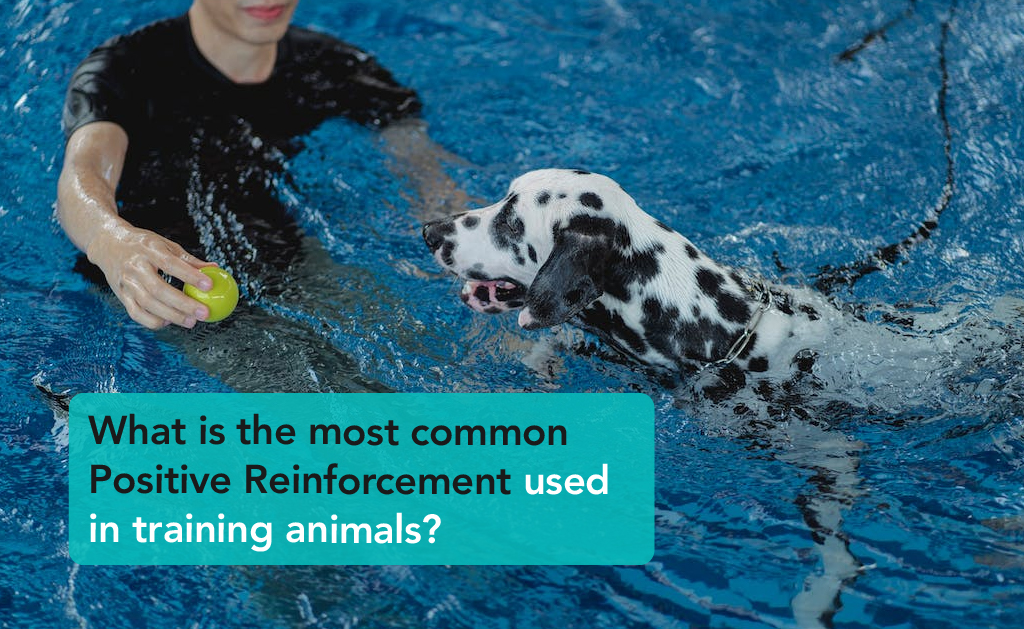
As animal lovers, we all want our furry friends to behave well and respond to our commands. But how do we achieve this without resorting to harmful or abusive methods?
Positive Reinforcement is a powerful and effective approach to animal training that has gained popularity in recent years. In this article, we will explore the concept of Positive Reinforcement, its benefits, and how it can be used to train animals.
While enrolling in animal training courses ensure a deep and complete understanding of what Positive Reinforcement is, reading this article will provide you with knowledge sufficient for a meaningful discussion.

What is Positive Reinforcement?
Positive Reinforcement is a training technique that rewards desirable behaviour in animals. The idea is to reinforce a behaviour by providing a reward that the animal finds pleasurable or desirable. This could come in the form of a treat, a toy, praise, or any other positive stimulus. The animal learns that by repeating the desired behaviour, they can receive the reward again.
How Does Positive Reinforcement Work?
Positive Reinforcement works by creating a link between the desired behaviour and the reward. When an animal performs a desirable behaviour and is rewarded, they learn that this behaviour is desirable and are more likely to repeat it in the future.
Over time, the desired behaviour becomes a habit, and the animal no longer needs the reward to perform it.
The Benefits of Positive Reinforcement
Positive Reinforcement has numerous benefits over other forms of training. Here are just a few:
1. It’s Humane and Ethical
Positive Reinforcement is a humane approach to animal training. It does not involve physical punishment, fear, or intimidation, which can be harmful and cause long-term emotional damage to animals.
2. It’s Effective
It is an effective way to train animals. By rewarding desirable behaviour, you are encouraging the animal to repeat it, which leads to faster and more consistent results.
3. It Builds Trust and Bonding
Positive Reinforcement helps to build trust and bonding between the animal and the trainer. By providing positive feedback and rewards, the animal feels appreciated and valued, which leads to a stronger relationship between the animal and the trainer.
4. It Promotes Good Behaviour
It promotes good behaviour by rewarding desirable actions. This approach focuses on what the animal is doing right, rather than punishing them for what they are doing wrong.

How to Use Positive Reinforcement in Animal Training
Positive Reinforcement can be used to train a wide range of animals, including dogs, cats, horses, birds, and even exotic animals like tigers and elephants. Here are some tips on how to use positive reinforcement in animal training:
1. Identify the Desired Behaviour
The first step in using positive reinforcement is to identify the behaviour that you want to reinforce. This could be sitting, staying, coming when called, or any other behaviour deemed good.
2. Choose the Reward
The next step is to choose the reward that you will use to reinforce the behaviour. As already mentioned, this could be a treat, a toy, praise, or any other positive stimulus that the animal enjoys.
3. Reward the Behaviour
When the animal performs the desired behaviour, immediately reward them with the chosen stimulus. Be consistent and provide a reward every time the behaviour is performed.
4. Repeat and Reinforce
Repeat the process of rewarding the behaviour every time it is performed. Over time, the animal will learn that performing the behaviour leads to a reward, and they will be more likely to repeat it.

What is the most common Positive Reinforcement used in training animals?
The most common Positive Reinforcement reward used in training animals is food. This could be treats or the animal’s regular food. Others could include toys and forms of play.
Why is Positive Reinforcement training the preferred method in managing animals in zoos?
Positive Reinforcement is the preferred method in managing animals in zoos because it is a humane and ethical approach that promotes good behaviour and builds trust between the animals and their trainers. It is also a highly effective training technique that produces consistent and reliable results.
What is an example of Positive Reinforcement in animals?
An example of positive reinforcement in animals is when a dog performs a desired behaviour, such as sitting or staying, and is immediately rewarded with a treat or praise. Over time, the dog learns that performing the behaviour entitles it to a reward. This results in repeated performances in future.
What is Positive Reinforcement Dog Training?
Positive reinforcement dog training is a training technique that uses rewards to encourage and reinforce desirable behaviour in dogs. This approach focuses on rewarding good behaviour rather than punishing bad behaviour, which creates a more positive and effective training experience for both the dog and the trainer.
What is the purpose of Positive Reinforcement?
The purpose of Positive Reinforcement is to create a strong bond between the dog and the trainer, promote good behaviour, and achieve faster and more consistent results in training.
How to train a dog with Positive Reinforcement
To train a dog with positive reinforcement, you need to identify the desired behaviour, choose a reward that the dog enjoys, reward the behaviour immediately, and repeat the process consistently. This technique can be used to train a wide range of behaviours, including sitting, staying, and coming when called, among a host of others.
Does Positive Reinforcement in Dog Training work?
Positive Reinforcement dog training is a highly effective and proven training method that produces consistent and long-lasting results. It has numerous benefits over other forms of training, including being humane, effective, and promoting good behaviour.
Is Permission-Based Training different from Positive Reinforcement in Dog Training?
Permission-Based Training is a type of Positive Reinforcement dog training that involves asking the dog for permission before providing a reward. This technique helps to build trust and communication between the dog and the trainer and reinforces desirable behaviours.

Good Behaviour and Performance Are Worth Rewarding
Positive Reinforcement is a powerful and effective approach to animal training that has numerous benefits over other forms of training. By using rewards to reinforce desirable behaviour, you can build a stronger bond with your animal, promote good behaviour, and achieve faster and more consistent results without the danger of emotional damage.
Want to deepen your study on Positive Reinforcement? Sign up for animal training courses here in Careers Collectiv!